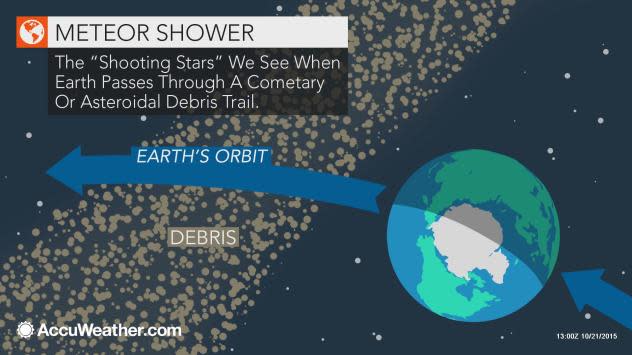Don't miss it: Eta Aquarids meteor shower to peak Tuesday night
Shooting stars will grace the night sky during the first week of May as a meteor shower, which has origins that can be traced back to one of the most famous comets in recent history, peaks.
The Eta Aquarids meteor shower will reach its climax on the night of Tuesday, May 4, into the early morning of Wednesday, May 5, the first of three big astronomical events in May.
This is the second meteor shower in under three weeks, providing a great opportunity to skywatchers who missed out on April's Lyrid meteor shower, which peaked on Earth Day.
The term "shooting stars" can be misleading as the objects people will see streaking across the sky are not stars at all, but rather tiny pieces of dust and debris that have broken off a comet or asteroid and burn up while entering Earth's atmosphere.
The comet responsible for the space dust that sparks the annual Eta Aquarids is none other than Halley's Comet.
Halley's Comet pays a visit to the inner solar system about once every 75 years, putting on a show in the night sky and leaving behind a trail of debris. This debris is typically small and is not much bigger than a grain of sand.
Every year in early May, the Earth passes through part of this field of debris left behind by the comet's previous orbits around the sun, setting off the Eta Aquarid meteor shower.
 |
Debris from Halley's Comet is also responsible for the Orionids meteor shower, which peaks every October, although it is typically not as strong as the Eta Aquarids.
These meteor showers are the closest that stargazers will come to seeing Halley's Comet until 2061 when it once again zips through the inner solar system.
 |
Comet P/Halley as taken March 8, 1986 by W. Liller, Easter Island, part of the International Halley Watch (IHW) Large Scale Phenomena Network. (Image/NASA) |
The Eta Aquarids is the best meteor shower of the entire year for the Southern Hemisphere, outperforming popular showers later in the year, such as the Perseids in August and the Geminids in December. These other showers are still visible south of the equator but with fewer meteors when compared to the northern latitudes.
Between 40 and 60 meteors per hour may be counted from areas south of the equator, averaging nearly one a minute, but people across the Northern Hemisphere shouldn't snub this event.
"From the equator northward, they usually only produce medium rates of 10-30 per hour just before dawn," the American Meteor Society said. This is similar to the rates seen during the Lyrids.
Regardless of location, the best time to view the meteor shower will be after 2 a.m., local time, as long as the weather cooperates.
CLICK HERE FOR THE FREE ACCUWEATHER APP
In North America, the best weather is expected across the Southwest, although people will need to travel far away from the city lights of places like Los Angeles or Phoenix for the best viewing conditions.
Folks across much of the rest of the United States and into Canada will not be as fortunate as a pair of far-reaching storm systems spread disruptive clouds over large areas.
 |
If poor conditions are in the offing for Tuesday night, stargazers can try their luck later in the week if the weather improves.
"Activity is good for a week centered [around] the night of maximum activity," the AMS said.
 |
After the Eta Aquarids come and go, there will be a nearly three-month period where no moderate meteor showers unfold in the night sky. However, as the saying goes, good things come to those who wait.
On the night of July 28, two meteor showers will peak at the same time, the Southern Delta Aquarids and the Alpha Capricornids. These will be an appetizer for the Perseids in early August, arguably the best meteor shower of the entire year.
Keep checking back on AccuWeather.com and stay tuned to the AccuWeather Network on DirecTV, Frontier, Spectrum, FuboTV, Philo, and Verizon Fios.





